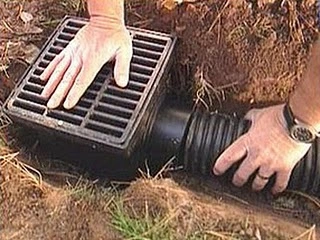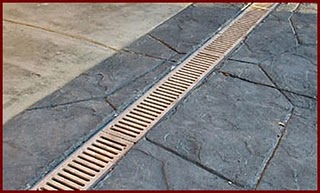French Drain
Oklahoma Drainage and Sprinkler Repair — Installing – French Drains – Surface Drains – Channel Drains – Sump Pumps
Providing Expert Sprinkler Repair – Broken Sprinkler Pipes – Sprinkler Head Adjustment – Sprinkler Valve Replacement
Servicing all of Central and Western Oklahoma since 1993.
Oklahoma Drainage and Sprinkler Repair has been diagnosing and solving Drainage Problems since 1993. Water has the ability to get into places around your home where you really don’t want it to be. Some drainage problems are easy to solve. Typically water enters the problem drainage area one way from one source. The really tricky drainage problems occur when water enters the problem drainage area from multiple directions and from multiple sources. Sometimes a secondary water source can’t be seen or identified until the primary water problem source is eliminated.
An example of this occurs when water is running into a problem area, in an obvious way, over the ground where you can see it.
Simple enough.
A drainage system is installed with a surface drain as the “intake” with drainage pipe running to an exit point. Initially the water drains away and everything looks great. The next day water is back and is all around the surface drain, but below the edge and it hasn’t rained at all, so no additional water ran over the surface of the ground to flood the area. The primary water source was solved, ( The surface water run off ) but the secondary water source was not. Which was sub-surface water, (ground water) running into the area. A surface drain can’t drain “ground water.” A French Drain should have initially been installed instead of a Surface Drain. A French Drain can drain both Surface Water and Ground Water All Drainage Systems and French Drains as well need a place to take the water to. This is called an Exit Point. We use two types of Exits. The first is a curb outlet. We cut the curb with a concrete saw and install a rectangular curb outlet set in acrylic concrete.

Curb outlet with more than 6 inches of fall
A rectangular outlet is superior to a round one. Air travels back up the pipe through the top two corners to allow a more continuous water flow. If you have ever poured liquid out of a 2 liter bottle turning it completely upside down, you will see that it drains but not very well.
Oklahoma Drainage and Sprinkler Repair installs a variety of other types of Drains. Our Drainage Systems may utilize: French Drains, Surface Drains, Channel Drains, Trench Drains, Basin Drains, and Sump Pumps. In the past 26 years, we have installed French Drains to keep water away from home and business foundations, Surface Drains to keep water away from sidewalks and driveways, Trench Drains, and French Drains to keep standing water out of flowerbeds and yards, and Sump Pumps to remove water from basements and outdoor low lying areas.
Wow, Some Drainage Problems are tougher than others. Had a customer in Chickasha with an unusual Drainage Problem. She had a new Driveway installed. The Cement work was nice enough but they left out one major consideration when installing the new Driveway. Even after a small rain the water would run right down the driveway, under the Garage Door and directly into the Garage. This was a bad problem that was about to get worse. The first big rain came and everything was magnified. The Rushing water took out the garage door and the back wall of the garage. Yikes!!
Hmm,? What to do? The company that installed the Driveway was nowhere to be found. No surprise.
The water volume was huge and the customer had no means to redo the driveway which was substantial.


Decorative French Drain Connected to Channel Drain
The solution took a little “Out Of The Box Thinking”.
We Installed an 8 inch metal channel drain grate across the driveway. But with no channel drain underneath. A large channel drain could not handle the water volume that we were dealing with. Instead of installing a channel drain underneath the grate, we cut completely through the driveway concrete and installed two 6 inch French Drains stacked on top of each other underneath the Channel Drain Grate.
This took place in July of 2017. Since then not a drop of water has reached the garage.
We put two French Drains under a larger version of a drain that looks like the above picture.
Drainage Systems can be made up of one drain or a combination of many drains. Drainage problems can be very complex. Complex Drainage Problems may require a combination of several different types of drains all inter-connected and working together. Other times the drainage problem may be simple and straight-forward requiring only one drain or several of the same type of drain connected together.


French Drain Installed, Water is gone, just need to clean the mud off the sidewalk
French Drains can utilize several types and sizes of French Drain Pipe. An older type that is not commonly used any more is 4 inch PVC Pipe with large half inch holes drilled in the Pipe. This doesn’t work very well, Because the holes are too large and the number of holes in the French Drain Pipe are too few. Also there is no filter or “Soc” around this particular French Drain Pipe. If it is used in sandy or loose soil the holes will clog and the pipe will fill up with sand. PVC French Drain Pipe should be avoided.
ADS French Drain Pipe is much better, the holes are smaller and much more numerous. It also comes inside a soc that acts as a filter and helps keep sand and debris out of the French Drain Pipe. It works very well.
For Small business and Residential French Drains, Four inch ADS Perf/Soc French Drain pipe is adequate and the most common. It is used for the majority of all French Drains installed. French Drains can be installed using 3 inch ADS Perf/Soc but many times it is too small and can be overwhelmed by a heavy rain or from a bad design. (Too many gutter down spouts connected directly into the French Drain, For Example) Three Inch French Drain Pipe should be avoided if possible.
Six inch ADS Perf/Soc French Drain Pipe is usually a good idea when possible. It carries a much larger volume of water. Six Inch French Drains are rarely overwhelmed.


The Drawbacks to 6 inch French Drain installation are:
1. The Materials Cost is higher for six-inch French Drain Compared to Four Inch Pipe. 2. Many times 6 Inch French Drain Pipe is too large for many applications, Such as going under a fence or sidewalk. 3. The trench for a 6 inch French Drain must be much larger than a 4 Inch 4. The amount of gravel or limestone or River Rock used to Cover the 6 inch French Drain is Much larger All things being considered, the performance and longevity of a 6 inch French Drain is well worth it if you are trying to protect something of value to you! If the higher cost and the additional labor and materials are not a problem and 6 inch French Drain pipe is not too big for what you want to do then a 6 inch French Drain would be the best.










































































